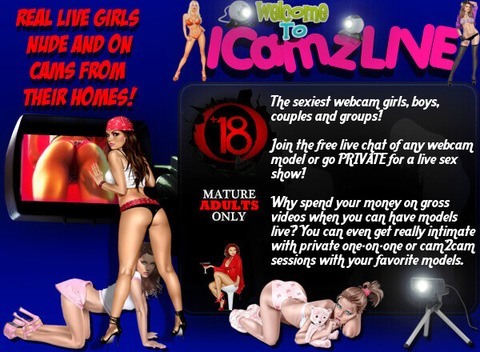Cam Models Blog
All you need to know about Cam Modeling plus Tips & Advice for your Success!
Subscribe to our RSS feed for real-time updates.

By Paolo Lugarà. Author of the ebook How To Become a Top Paid Webcam Model.
He is a blogger, agent and owner of I-Camz.net. You can reach him here.
A Guide to Internet Connections for Webcam Models
With technology, including internet connect speeds and how content is made available over the Web, changing rapidly, cam models need to have an understanding of their internet connection options. After all, internet connection, for cam models, can drastically impact how well their shows go. The following information is designed to help webcam models make the best internet connection decisions based on their available options.
First, it is important to understand that the connection speeds discussed below only provide a look at general average to maximum speed times. As technology advances, they are likely to change. In addition, the speeds are likely to vary depending on your Internet Service Provider (ISP). It's also important to note that your ISP can be a significant factor in how happy or frustrated you are when performing on camera. Depending on where you live, you may have a wide selection of ISPs to select from. Unfortunately, models in some locations may have very few options.
Types of Internet Connections
Today, the four most common connection types, which vary in both cost and speed capabilities (measured in megabits per second, or Mbps), are:
Many webcam girls who work from home appreciate that it allows them to hide their job from the outside world. There's no need to walk outside "dressed" for work or carrying accessories that will attract your neighbor's attention. As an added bonus, they also never have to worry that someone else has used any personal accessories before them.
Important Things to Know About the Different Types of Internet Service
The term "broadband" is used to cover types of internet connections that are always-on, including DSL, cable, satellite, and fiber-optic service (also known as FiOS). These high-speed services ensure that you are consistently connected to the internet.
Your other option is dial-up (remember when you were growing up and everyone had to stay off the landline when someone was trying to go online). Yes, this is still available and people actually pay for and use it. However, you should really only use dial-up if it is your absolute only option.
Cable, especially if you agree to pay for the higher priced plans that offer incredibly fast speeds, is simply a better option than satellite. With cable, there is no need to worry about your data usage. However, this can mean that you will see your service speed slowdown during peak hours because so many users are using bandwidth.
Currently, satellite is definitely taking steps toward improvement. As each new communication satellite launches, the signals become stronger. In fact, there may be a day when cable has gone the way of dial-up.
It is highly recommended that you use a direct internet connection for two important reasons. It makes your shows clearer and faster. While Wi-Fi connections technically will work, they aren't preferred because the connection is often slower. To keep your shows from lagging and to improve your chances of getting a full chatroom and making plenty of money, you absolutely need high-speed internet. In fact, some networks will not allow webcam models to work if their internet connection is too slow.
Now, here's a brief look at the different types of broadband connections currently available to consumers.
Digital Subscriber Line (DSL)
Although DSL operates over regular phone lines (like dial-up), it delivers download speeds that are as fast as 25 megabits per second or more. DSL is broken down into two types:
There are advantages to DSL, starting with the fact that it tends to be your least expensive broadband option and is usually available through multiple providers (as opposed to a single fiber-optic or cable provider). In addition, speeds tend to be stable and consistent, largely because you usually get a dedicated line.
There are also disadvantages to DSL. For example, how far you are from the provider's central office can have a drastically negative impact on the reliability and speed of your connection. In addition, DSL isn't as fast as other broadband options, though it is faster than dial-up and usually meets most users needs.
Cable Broadband
Available through your cable provider, cable broadband operates over coaxial cable TV wires and has an average download speed that ranges from 3 Mbps to more than 100 Mbps.
There are advantages to cable. For example, unlike DSL, your speed and quality are not affected by your distance to the central office. In addition, cable tends to be much faster than satellite and DSL, as well as more readily available than fiber-optic broadband.
The major disadvantage to cable is the fact that your available bandwidth is typically shared with others in your neighborhood. As a result, the more people who are using it at the same time, the slower the service will be for everyone.
Satellite
Regardless of where you are, satellite offers speeds of up to 3 Mbps uploading and 15 Mbps downloading, thanks to the satellites that are used to beam the internet feed to subscribers' installed satellite dishes.
Advantages to satellite include its ability to cover areas, especially rural areas, where cable, DSL and fiber-optic are not available. Unfortunately, there are disadvantages to satellite; specifically that it tends to be more expensive and slower than other broadband options.
Fiber-optic Service (FiOS)
FiOS is the newest type of internet connectivity and works over an optical network using light. Currently, providers offer speeds as high as 65 Mbps uploading and 300 Mbps downloading. While FiOS offers the highest speeds available ("at the speed of light"), it is only available in limited areas at the current time.
Dial-Up
If you are unable to access the internet using cable or DSL, dial-up may be your only option. Unfortunately, it is slow, with a top speed of around 56Kbps and it frequently gets disconnected. Additionally, it is not constantly available and it takes away your ability to talk on a landline when it is in use.
Conclusion
For webcam models, this is basically what you need to know. Your fastest provider available is cable, followed by DSL, satellite, and dial-up. If you live in an area where cable or DSL is not available, satellite and dial-up are essentially your only options. Ultimately, cable and DSL are your top high-speed internet connection options.
Now, it's time to choose which one is best for you.
About Us

I-Camz.net is 100% real agent founded site offering I-Camz.com highest paying webcam jobs in the industry, with the best payouts for live cam shows!
ICamzLIVE

Don't forget to try adult sex chat with our Live Cam Models, it's hot!





